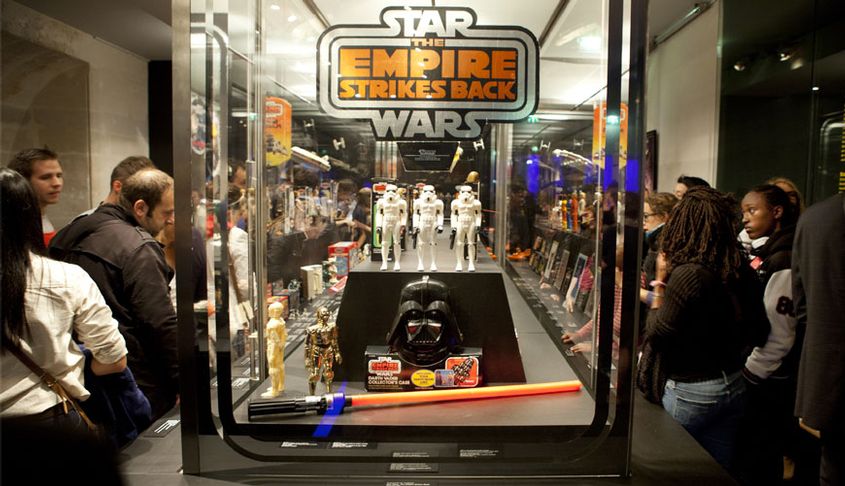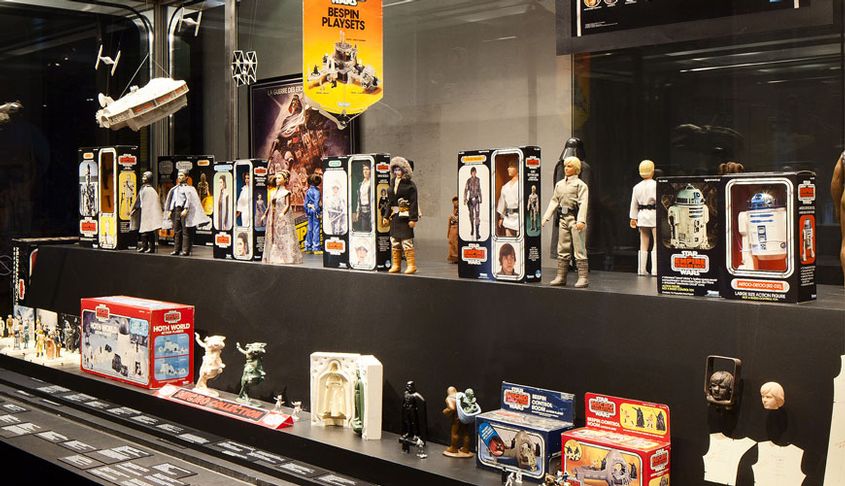STAR WARS TOYS - THE EXHIBITION
This exhibition, produced by ScienceFictionArchives.com took place from October 4th 2012 to March 17th 2013 at the toy Gallery of Musée des Arts Décoratifs in Paris, France.
The exhibition did retrace the thirty-five-year history of the saga's toys and spin-off merchandise, revealing the full scope of this extraordinary legacy passed down from generation to generation.
The universe created by George Lucas has generated countless toys, games, comic books and a whole range of other products. A selection of four hundred toys and objects, mainly figures produced byHasbro and its subsidiary Kenner, showed in an exhibition design by the French collective H5. Displayed in the chronological order of the films' releases, the toys' various production stages will also be revealed, from prototype to the final product, as well as the fabrication secrets of some of the most popular toys of all time.
All these articulated figures, dolls, outfits, masks, spacecraft, soft toys and video games come from a single, French collection, that of ScienceFictionArchives.com, the company Arnaud Grunberg founded in 2008 to preserve and showcase the several thousand science-fiction-related toys and objects he began collecting in 1977, the year Star Wars was released. His collection encompasses thousands of toys and games inspired by the saga, some of which was shown in public for the first time.
Star Wars is divided into two parts. The first, Episodes I to III (released between 1999 and 2005), tell the story of the fall of Anakin Skywalker, who becomes Darth Vader, and how the Galactic Republic progressively becomes the Empire. The second part, Episodes IV to VI (released between 1977 and 1983), recount the initiatic journey of Luke Skywalker, culminating in his father's redemption.
The six films released between 1977 and 2005 were revolutionary, particularly in their use of visual effects, which enabled Lucas to realise his vision and create dazzlingly compelling and original imagery. Their success was such that Star Wars is now embedded in popular culture and our collective memory.
Star Wars also benefited from contributions by artistic geniuses, for whom Lucas's films provided free rein for their talents. Ralph McQuarrie, formerly an illustrator at Boeing, was the first to illustrate the screenplay, and Joe Johnston drew many of the spacecraft and storyboards. But one of the most iconic images will always be Tom Jung's 1977 poster with the film's emblematic phrase, “A long time ago in a galaxy far, far away...”, with the figures of Luke Skywalker brandishing his Lightsaber and Princess Leia sitting in the foreground, standing out against the looming helmet of Darth Vader. In 1977 George Lucas asked two heroic fantasy and science fiction illustrators, the brothers Greg and Tim Hildebrandt, to produce another, more comic strip-style version of the poster. The centerpiece of this iconic image, reproduced on the original toy packages, was also the poster for this exhibition. Indeed the original painting, and which was part of Allan Ladd Jr.'s collection during many years, was shown to the public for the first.
Bernie Loomis, then president of the Amercian toy manufacturer Kenner, bought the Star Wars world license a month before the film was released in May 1977 and began creating a line of toys based on the film's characters and universe. The film's colossal box office success had already created huge merchandising demand, and Christmas was only seven months away, insufficient time to produce the toys children were waiting for. So Loomis took two decisions: firstly that the figure should be only 10cm tall, enabling the company to produce affordable accessory vehicles (this format is still the norm with toy manufacturers today, over thirty years later), and secondly he took the risk of launching a special offer, the “Early Bird Certificate Package,”a cardboard package with a mail-away certificate to get the first four figures a few months later. Kenner franchised local toy distributors in each country to market its toys, either subsidiaries or partners with whom the company already had commercial ties, such as Meccano in France.
Over 250 million figures were sold worldwide from 1978 to 1983. The first twelve were the most collected and are now the most sought after in their original packaging: Princess Leia, Luke Skywalker, Chewbacca, R2-D2, C-3PO, Han Solo, Darth Vader, Obi-Wan Kenobi, Imperial Stormtrooper, Jawa, Sand People and Death Squad Commander. Now, in 2012, a complete collection comprises close to 2,500 characters.
Approximately one hundred of the series' spacecraft have also been produced since 1978. The X-wing fighter, the TIE fighter and the landspeeder were the first marketed, and they were joined by Darth Vader's TIE fighter and the Millennium Falcon in 1979. All these vessels were soon crewed by the films' characters, enabling children to recreate the film's universe by re-enacting scenes. Following the success of these toys, each new episode had its star spacecraft: the AT-AT in The Empire Strikes Back, 60 centimetres high, , and the Imperial Shuttle, star of the opening scene of Return of the Jedi. Kenner also reproduced the speeder bike chase through the woods of Endor, one of the highpoints of Return of the Jedi. The vehicle has an ingenious spring mechanism that can “explode” the bike in flight as it did in the film.
The line of Star Wars toys was complemented by a series of twelve dolls. The R2-D2, Chewbacca and Jawa plush toys were launched as soon as Star Warswas released, and the Ewoks appeared with Return of the Jedi. Masks and outfits, produced by the French manufactuer César, were marketed from 1978 (Darth Vader, Chewbacca, Sand People, Imperial Stormtrooper), enabling children to actually become their favourite characters. The C-3PO mask was included in the outfits marketed by the French manufacturer Panache Blanc, comprising a tunic, trousers and even a laser pistol.
Approximately one hundred figures were produced in the years spanned by the first three films. In the early 1990s, when the Star Wars phenomenon was settling, Lucasfilm relaunched the franchise with new Star Wars novels. In 1995, Hasbro marketed a new line of figures, and two years later the Star Wars saga was again triumphing with the release of a special edition and the announcement that three new films were going into production.
Most of the objects on display during the exhibit came from the first trilogy: Star Wars (1977), The Empire Strikes Back (1980) and Return of the Jedi (1983). Today's children will discover the toys their parents once played with, and their joy in becoming their heroes and characters, re-enacting scenes and collecting these beautiful toys. Never before or since in cinema or toy history has there been such a phenomenon.
Children will also rediscover the toys produced by Hasbro for the prequel episodes (The Phantom Menace, Attack of the Clones, Revenge of the Sith), including the 2012 range. The full scope of the collection was shown in display cases focussing on toy lines, countries, typologies and also featuring toy-scale recreations by the H5 collective of the films' mythical scenes: the desert planet Tatooine, the Ewok village on Endor, the attack on the Death Star, and the Geonosis Arena.
Adult Star Wars aficionados did also appreciate the collection's rarities: original sculptures of figures, doll moulds, plaster masks, prototypes of toys never produced, retouched photographs reproduced on blister packs, package prototypes, printing samples, shop displays, etc. They also discover iconic paintings and illustrations featured on Star Wars products, and again hear the iconic sounds of the Lightsaber and Darth Vader's voice.
A selection of seven video games for console and PC based on the film franchise did show the evolution in computer graphics, from The Empire Strikes Back, released on Atari 2600 in 1983,to Star Wars: The Old Republic (2011). In the most recent, Kinect Star Wars,launched in April 2012, players actually became the controller and engage in a new immersive experience.
The Exhibition organized by ScienceFictionArchives.com with the partnership of Les Arts Décoratifs, Paris, the French Ministry of Culture and Communication, in collaboration with Hasbro France and with the sponsorship of La Grande Récré, Toy Gallery sponsor since 2006, and bank BRED and with Lucasfilm authorization.
Have a souvenir of the exhibition in the catalogue ScienceFictionArchives.com : Album des Exposition 2012
Pictures
Curators :
- Dorothée Charles, curator in charge of the Arts Décoratifs Toys Departement, assisted by Laura Gaudenzi
- Benjamin Fleurier, ScienceFictionArchives.com Archives Manager
- Patrice Girod, ScienceFictionArchives.com Exhibitions Manager
- Arnaud Grunberg ScienceFictionArchives.com Founder and Managing Director
Scenography :
Rachel Cazadamont and Emmanuel Prévot from H5
Star Wars Toys : The Exhibition was organized by Callisto Exhibition Group and developed in partnership with Hasbro and Lucasfilm Ltd.
photo : Star Wars Toys : The Exhibition at Arts Décoratifs. Star Wars © 2012 Lucasfilm Ltd. All Rights Reserved











